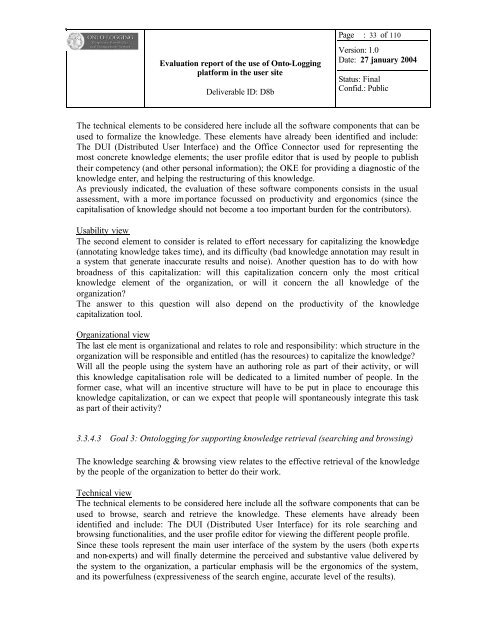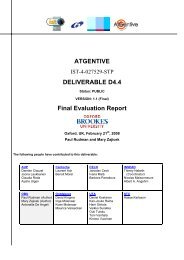pdf 820Kb - INSEAD CALT
pdf 820Kb - INSEAD CALT
pdf 820Kb - INSEAD CALT
You also want an ePaper? Increase the reach of your titles
YUMPU automatically turns print PDFs into web optimized ePapers that Google loves.
Evaluation report of the use of Onto-Logging<br />
platform in the user site<br />
Deliverable ID: D8b<br />
Page : 33 of 110<br />
Version: 1.0<br />
Date: 27 january 2004<br />
Status: Final<br />
Confid.: Public<br />
The technical elements to be considered here include all the software components that can be<br />
used to formalize the knowledge. These elements have already been identified and include:<br />
The DUI (Distributed User Interface) and the Office Connector used for representing the<br />
most concrete knowledge elements; the user profile editor that is used by people to publish<br />
their competency (and other personal information); the OKE for providing a diagnostic of the<br />
knowledge enter, and helping the restructuring of this knowledge.<br />
As previously indicated, the evaluation of these software components consists in the usual<br />
assessment, with a more im portance focussed on productivity and ergonomics (since the<br />
capitalisation of knowledge should not become a too important burden for the contributors).<br />
Usability view<br />
The second element to consider is related to effort necessary for capitalizing the knowledge<br />
(annotating knowledge takes time), and its difficulty (bad knowledge annotation may result in<br />
a system that generate inaccurate results and noise). Another question has to do with how<br />
broadness of this capitalization: will this capitalization concern only the most critical<br />
knowledge element of the organization, or will it concern the all knowledge of the<br />
organization?<br />
The answer to this question will also depend on the productivity of the knowledge<br />
capitalization tool.<br />
Organizational view<br />
The last ele ment is organizational and relates to role and responsibility: which structure in the<br />
organization will be responsible and entitled (has the resources) to capitalize the knowledge?<br />
Will all the people using the system have an authoring role as part of their activity, or will<br />
this knowledge capitalisation role will be dedicated to a limited number of people. In the<br />
former case, what will an incentive structure will have to be put in place to encourage this<br />
knowledge capitalization, or can we expect that people will spontaneously integrate this task<br />
as part of their activity?<br />
3.3.4.3 Goal 3: Ontologging for supporting knowledge retrieval (searching and browsing)<br />
The knowledge searching & browsing view relates to the effective retrieval of the knowledge<br />
by the people of the organization to better do their work.<br />
Technical view<br />
The technical elements to be considered here include all the software components that can be<br />
used to browse, search and retrieve the knowledge. These elements have already been<br />
identified and include: The DUI (Distributed User Interface) for its role searching and<br />
browsing functionalities, and the user profile editor for viewing the different people profile.<br />
Since these tools represent the main user interface of the system by the users (both expe rts<br />
and non-experts) and will finally determine the perceived and substantive value delivered by<br />
the system to the organization, a particular emphasis will be the ergonomics of the system,<br />
and its powerfulness (expressiveness of the search engine, accurate level of the results).
















